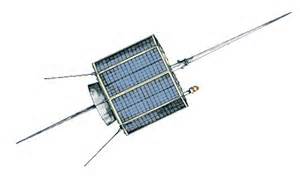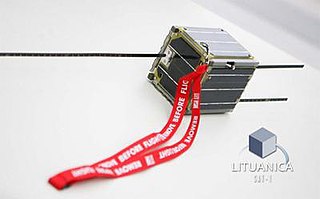| Names | AO-6 |
|---|---|
| Mission type | Amateur radio |
| Operator | AMSAT / NASA |
| COSPAR ID | 1972-082B |
| SATCAT no. | 6236 |
| Mission duration | 4.5 years (achieved) |
| Spacecraft properties | |
| Bus | AMSAT-OSCAR |
| Manufacturer | AMSAT-NA |
| Launch mass | 18.2 kg (40 lb) |
| Dimensions | 16 cm × 30 cm × 44 cm (6.3 in × 11.8 in × 17.3 in) |
| Power | 3.5 watts |
| Start of mission | |
| Launch date | 15 October 1972, 17:19 UTC |
| Rocket | Delta 300 (Delta 91 / Thor 575575) |
| Launch site | Vandenberg, SLC-2W |
| Contractor | Douglas Aircraft Company |
| End of mission | |
| Last contact | 21 June 1977 |
| Orbital parameters | |
| Reference system | Geocentric orbit [1] |
| Regime | Low Earth orbit |
| Perigee altitude | 1,448 km (900 mi) |
| Apogee altitude | 1,457 km (905 mi) |
| Inclination | 101.70° |
| Period | 114.93 minutes |
AMSAT-OSCAR 6 (a.k.a. AO-6) was the first Phase 2 amateur radio satellite (P2-A) launched into low Earth orbit. It was also the first satellite constructed by the new AMSAT North America (AMSAT-NA) organization.
The satellite was launched 15 October 1972, by a Delta 300 launcher from Vandenberg Air Force Base, Lompoc, California. AO-6 was launched piggyback with NOAA-2 (ITOS-D).
AMSAT-OSCAR 6 was box-shaped, measuring 43 cm × 30 cm × 15 cm, with a mass of 18.2 kg. It had a near-circular polar orbit of 1448 × 1457 km with an inclination of 101.70°. It deployed two quarter-wave monopole antennas, one each for 144 and 435 MHz, and half-wave dipole antenna for 29 MHz. It remained operational for 4.5 years until a battery failure on 21 June 1977. [2] [3]
Equipped with solar panels powering NiCd batteries, AO-6 provided 24 V at 3.5 watts power to three transponders. It carried a Mode A transponder (100 kHz wide at 1 watt) and provided store-and-forward morse and teletype messages (named Codestore) for later transmission. Subsystems were built in the United States, Australia, and Germany. [4]
AO-6 had a 1.3 watt transmitter into a half-wave dipole antenna. AO-6's receiver input sensitivity was approximately -100 dBm (2 μV per meter) and had an Automatic gain control (AGC) that provided up to 26 dB of gain reduction optimized for single-sideband modulation. The transceiver team consisted of Karl Meinzer DJ4ZC, Wallace Mercer W4RUD, Dick Daniels WA4DGU and Jan King W3GEY.
AO-6 demonstrated several uses of new technologies and operations. [4]
AMSAT is a name for amateur radio satellite organizations worldwide, but in particular the Radio Amateur Satellite Corporation (AMSAT) with headquarters at Washington, D.C. AMSAT organizations design, build, arrange launches for, and then operate (command) satellites carrying amateur radio payloads, including the OSCAR series of satellites. Other informally affiliated national organizations exist, such as AMSAT Germany (AMSAT-DL) and AMSAT Japan (JAMSAT).
AMSAT-OSCAR-40, also known as AO-40 or simply OSCAR 40, was the on-orbit designation of an amateur radio satellite of the OSCAR series. Prior to launch, the spacecraft was known as Phase 3D or "P3D". AO-40 was built by AMSAT.

AMSAT-OSCAR 51 or AO-51 is the in-orbit name designation of a now defunct LEO amateur radio satellite of the OSCAR series; formerly known as ECHO, built by AMSAT. It was launched on June 29, 2004 from Baikonur Cosmodrome, Kazakhstan on a Dnepr launch vehicle. It is in sun synchronous low Earth orbit.
HAMSAT also known as HAMSAT INDIA, VU2SAT and VO-52 is a microsatellite weighing 42.5 kilograms (93.7 lb), providing amateur radio satellite communications services for Indian and international amateur radio operators. This satellite carries the in-orbit designation of VO-52, and is an OSCAR series satellite.

AMSAT-OSCAR 7, or AO-7, is the second Phase 2 amateur radio satellite constructed by the Radio Amateur Satellite Corporation or AMSAT. It was launched into Low Earth Orbit on November 15, 1974 and remained operational until a battery failure in 1981. Then after 21 years of apparent silence, the satellite was heard again on June 21, 2002 – 27 years after launch. At that time the public learned that the satellite had remained intermittently functional and was used surreptitiously for communication by the anticommunist opposition Fighting Solidarity during the martial law in Poland.
AMSAT-OSCAR 16, also known as AO-16 and PACSAT, is the in-orbit name designation of an amateur radio satellite of the OSCAR series. It was built by AMSAT and was launched on 22 January 1990 from Kourou, French Guiana on an Ariane 4 launch vehicle. It is in sun synchronous low Earth orbit.
Saudi-OSCAR 50 is a Saudi Arabian amateur radio satellite that was launched on 20 December 2002 by the King Abdulaziz City for Science and Technology.
An amateur radio satellite is an artificial satellite built and used by amateur radio operators. It forms part of the Amateur-satellite service. These satellites use amateur radio frequency allocations to facilitate communication between amateur radio stations.
Australis-OSCAR 5 is an amateur radio satellite that was launched into Low Earth Orbit on 23 January 1970 by a Thor Delta launcher from Vandenberg Air Force Base, Lompoc, California. AO-5 was launched piggyback with TIROS-M (ITOS-1) weather satellite).

OSCAR II is the second amateur radio satellite launched by Project OSCAR into Low Earth orbit. OSCAR II was launched June 2, 1962, by a Thor-DM21 Agena B launcher from Vandenberg Air Force Base, Lompoc, California. The satellite, a rectangular box weighing 10 kg (22 lb), was launched as a secondary payload (ballast) for Corona 43, the fifth launch of a KH-4 satellite.

OSCAR 3 is the third amateur radio satellite launched by Project OSCAR into Low Earth Orbit. OSCAR 3 was launched March 9, 1965 by a Thor-DM21 Agena D launcher from Vandenberg Air Force Base, Lompoc, California. The satellite, massing 15 kg (33 lb), was launched piggyback with seven United States Air Force satellites. Though the satellite's active life was limited to sixteen days due to battery failure, OSCAR 3 relayed 176 messages from 98 stations in North America and Europe during its 274 orbit life-time -- the first amateur satellite to relay signals from Earth. As of 2021, it is still in orbit.

LituanicaSAT-1 was one of the first two Lithuanian satellites. It was launched along with the second Cygnus spacecraft and 28 Flock-1 CubeSats aboard an Antares 120 carrier rocket flying from Pad 0B at the Mid-Atlantic Regional Spaceport on Wallops Island to the International Space Station. The launch was scheduled to occur in December 2013, but later was rescheduled to 9 January 2014 and occurred then. The satellite was broadcasting greetings of Lithuanian president, Mrs. Dalia Grybauskaitė. The satellite was deployed from the International Space Station via the NanoRacks CubeSat Deployer on February 28, 2014. All LituanicaSAT-1 subsystems have been turned on, tested and proved to be working properly. The mission is considered a complete success by its team of engineers. The mission ended upon the reentry and disintegration of the satellite on July 28, 2014.

FUNcube-1 is a complete educational single unit CubeSat satellite with the goal of enthusing and educating young people about radio, space, physics and electronics. It is part of a program which aims to launch more of these educational CubeSats. It is the first satellite with outreach as its primary mission.

Es'hail 2 is a Qatari satellite, launched aboard a SpaceX Falcon 9 rocket on November 15, 2018. Es'hail 2 was built by Japan's Mitsubishi Electric company, and will operate at 26° East longitude along a geostationary orbit to provide direct-to-home television services in the Middle East and North Africa region. The satellite will feature 24 Ku-band and 11 Ka-band transponders to provide direct broadcasting services for television, government and commercial content distribution. In addition to commercial services, the payload of Es'hail 2 includes a linear transponder with a bandwidth of 500 kHz and 8MHz for the amateur radio satellite service, with uplink on 2.4 GHz and downlink on 10.45 GHz.
Fox-1D, AO-92 or AMSAT OSCAR 92 is an American amateur radio satellite. Fox-1D is a 1U CubeSat developed and built by AMSAT-NA. Fox-1D carries a single-channel transponder for mode U/V in FM. Fox-1D has an L-band converter, which allows the FM transponder to be switched on an uplink in the 23 centimetres (9.1 in) band.
Fox-1B, AO-91 or AMSAT OSCAR 91 is an United States amateur radio satellite. It is a 1U Cubesat, was built by the AMSAT-NA and carries a single-channel transponder for FM radio. The satellite has a whip antenna for the 70 cm and 23 cm bands (uplink), and a second antenna for the 2 m band (downlink). Fox-1B is the second amateur radio satellite of the Fox series of AMSAT North America.
Fox-1A, AO-85 or AMSAT OSCAR 85 is an American amateur radio satellite. It is a 1U Cubesat, was built by the AMSAT-NA and carries a single-channel transponder for FM radio. The satellite has one rod antenna each for the 70 centimetres (28 in) and 2 metres bands. To enable a satellite launch under NASA's Educational Launch of Nanosatellites (ELaNa) program, the satellite continues to carry a Penn State University student experiment.
Fox-1Cliff, AO-95 or AMSAT OSCAR 95 is an American amateur radio satellite. Fox-1Cliff is a 1U CubeSat built by AMSAT-NA that carries a single-channel transponder for mode U/V in FM.
OSCAR 8 is an American amateur radio satellite. It was developed and built by radio amateurs of the AMSAT and launched on March 5, 1978 as a secondary payload together with the earth observation satellite Landsat 3 from Vandenberg Air Force Base, California, United States.